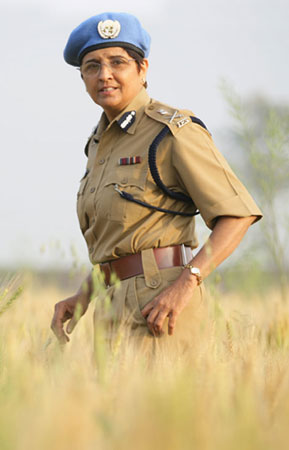skip to main |
skip to sidebar
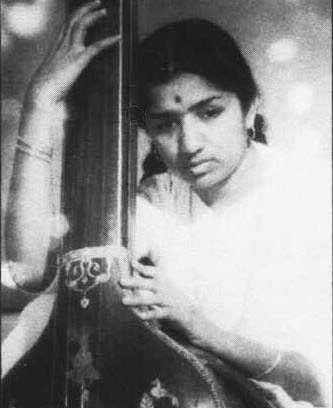 Lata Mangeshkar was born on September 28, 1929 in Indore to Maharashtrian parents.
Her father was Pandit Deenanath Mangeshkar, a classical singer theatre actor, and her mother Shudhhamati. Lata, named Hridaya at birth was renamed Lata after a female character Latika in her father's play. The first-born, Lata’s siblings are Asha, Hridayanath, Usha, and Meena. Her sister Asha Bhosle is also an accomplished and well-known singer.
The Queen of Melody started her career in 1942 and has sung for over two thousand Bollywood movies. She is the second vocalist to have received the Bharat Ratna, India's highest civilian honour. She also gained a mention in the Guiness Book of World Records from 1974 to 1991 for the highest recordings in the world.
Lata Mangeshkar was born on September 28, 1929 in Indore to Maharashtrian parents.
Her father was Pandit Deenanath Mangeshkar, a classical singer theatre actor, and her mother Shudhhamati. Lata, named Hridaya at birth was renamed Lata after a female character Latika in her father's play. The first-born, Lata’s siblings are Asha, Hridayanath, Usha, and Meena. Her sister Asha Bhosle is also an accomplished and well-known singer.
The Queen of Melody started her career in 1942 and has sung for over two thousand Bollywood movies. She is the second vocalist to have received the Bharat Ratna, India's highest civilian honour. She also gained a mention in the Guiness Book of World Records from 1974 to 1991 for the highest recordings in the world.
A child prodigy, Lata took her early music lessons from her father.
Her favourite singer was KL Saigal. She has had limited formal schooling.

Lata Mangeshkar was very young when her father passed away, thus making the family dependant on Lata. To take care of her family's economic situation, Lata acted in as many as 8 films from 1942 to 1948. She debuted as playback singer in a Marathi film named Kiti Hasaal (1942). Unfortunately the song was edited out. Her first Hindi playback was for the film Aap ke Sewa Main (1947) but she did not get noticed. At that time, the film industry was ruled by female singers who had heavier and huskier voices like Noor Jehan, Shamshad Begum and Zohrabai Ambalewali. While auditioning for the movie Shaheed (1948), she was rejected on the account of her thin voice! But Ghulam Haider saw the potential in her and gave her a chance to sing in the film Majboor.
The song Dil Mera Toda finally got her noticed and it was touted as her breakthrough song. In 1949, she had four major hits from the films Barsaat, Andaaz, Dulari and Mahal. The song "Aayega Aanewala" from Mahal was a huge hit and Lata secured a firm position in the industry. The husky voices of all other singers became obsolete in front of the high pitched voice of Lata Mangeshkar. The music industry had a huge makeover with the arrival of Lata Mangeshkar. By the late 50's, the younger sister of Lata Mangeshkar known as Asha Bhonsle also came into the scene and they both were touted as the unbeatable voices of the industry.
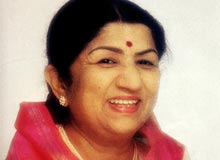
In the year 1945, she happened to meet the film producer S. Mukherji through Ghulam Haider. Haider personally wanted her to be given an opportunity to show her singing talent. However, S. Mukherji did not like her voice and said no for giving her a chance to sing for his film. At that point of time, Haider promised himself to establish her singing career in Bollywood. He even said to the producer that, one day will come when all the producers and directors will fall on her feet and beg her to sing in their films.
Lata got her biggest break, when she was given the chance to sing the song "Aayega Aanewaala" for the movie Mahal. The song was a super duper hit. The period of 1950s witnessed tremendous growth in her career. She rose to the top in the list of Bollywood singers. She worked with all the famous composers of that era like Shankar Jaikishan, S D Burman, Naushad, Hemant Kumar, and Salil Chowdhury. Shankar Jaikishan was absolutely stunned by her voice and used her voice for playback singing in almost all the movies that he got.
The period of 1960s made her the queen of Bollywood playback singing. She sang for almost all the prominent composers of the industry and set her foothold in Bollywood. Her songs got an overwhelming response from people all over the country. During the 1970s, Lata recorded songs for Bollywood actress Meena Kumari in the film Pakeezah, which brought her recognition and popularity. She performed tracks for S.D. Burman's films like Prem Pujari, Sharmilee, and Abhimaan.
In late 1970s and early 1980s, Lata Mangeshkar worked with the children of the music composers, with whom she had worked in the past. In the year 1990, Lata established her own production house. Their first and last film "Lekin" was a total flop. Mangeshkar has also sung some non film songs including ghazals with Jagjit Singh. Lata Mangeshkar has also sung for Yash Chopra`s films including Lamhe, Dilwale Dulhaniya Le Jayenge, Darr, Yeh Dillagi, and Dil To Pagal Hai. She sang quite a number of Bengali songs with renowned music directors like Salil Chowdhury and Hemant Kumar.

She is listed in the Guinness Book of World Records as the most recorded artist in the world. It is estimated that she has more than 30,000 solo, duet and chorus backed songs in 20 different languages from 1948 to 1987. Now, it must way over 40,000!
She actually monopolized the music industry and every music director wanted to work with her. She understood the requirement of each song and sang flawlessly. Lata Mangeshkar has been honored with innumerable awards but the one that truly deserves a special mention is that she is the only second singer in the non-classical category (after M.S Subbulakshmi) in India to have received the highest civilian award, Bharat Ratna. She has received three national awards and eight Filmfare awards after which she stopped accepting awards in order to promote new talent. She continues to sing every now and then for Hindi movies and perform live. Truly a living legend, Lata Mangeshkar has a talent that is second to none.
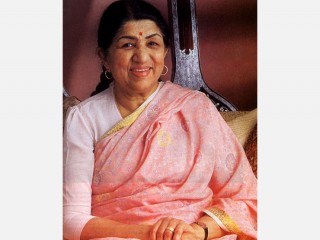
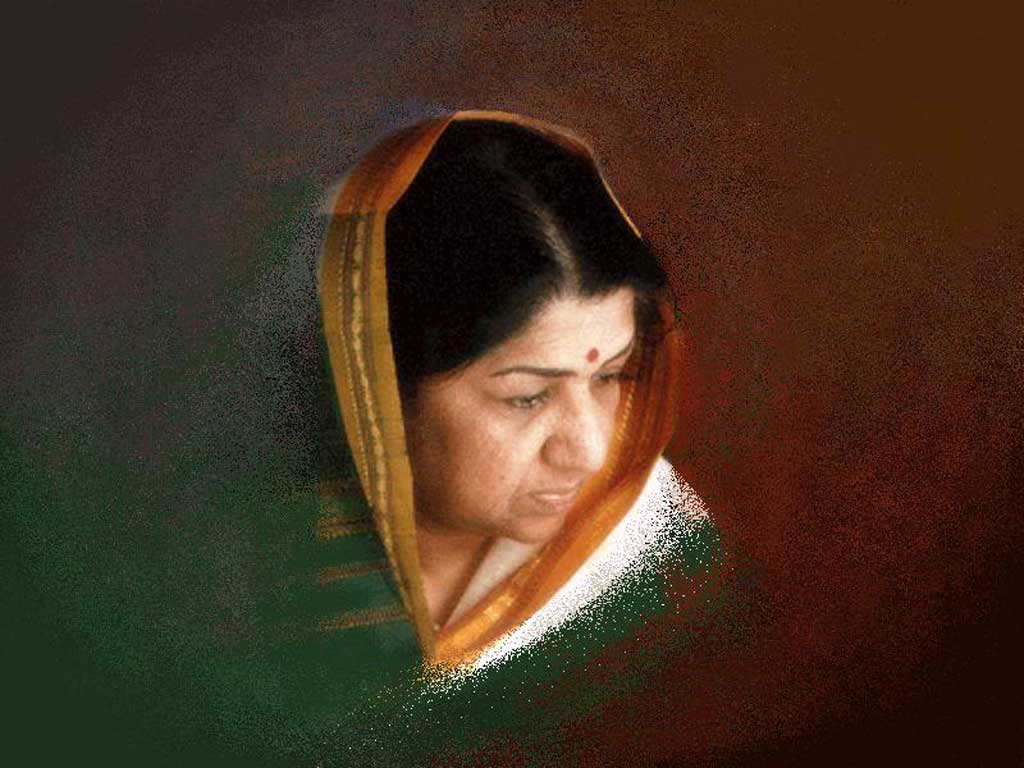

 Kiran Bedi was born on June 9, 1949. Her father Prakash Lal Peshawaria, a landlord in Punjab was determined to educate his four daughters at a time when women were largely limited to doing household tasks.
While studying at the Sacred Heart Convent, Kiran joined the National Cadet Corps (NCC) and took up tennis, a game which her father used to play.
After school she went on to study Political Science at the Government College for Women, Amritsar. She loved the subject as she felt it taught her about her role as a citizen of the country.
Kiran Bedi was born on June 9, 1949. Her father Prakash Lal Peshawaria, a landlord in Punjab was determined to educate his four daughters at a time when women were largely limited to doing household tasks.
While studying at the Sacred Heart Convent, Kiran joined the National Cadet Corps (NCC) and took up tennis, a game which her father used to play.
After school she went on to study Political Science at the Government College for Women, Amritsar. She loved the subject as she felt it taught her about her role as a citizen of the country.
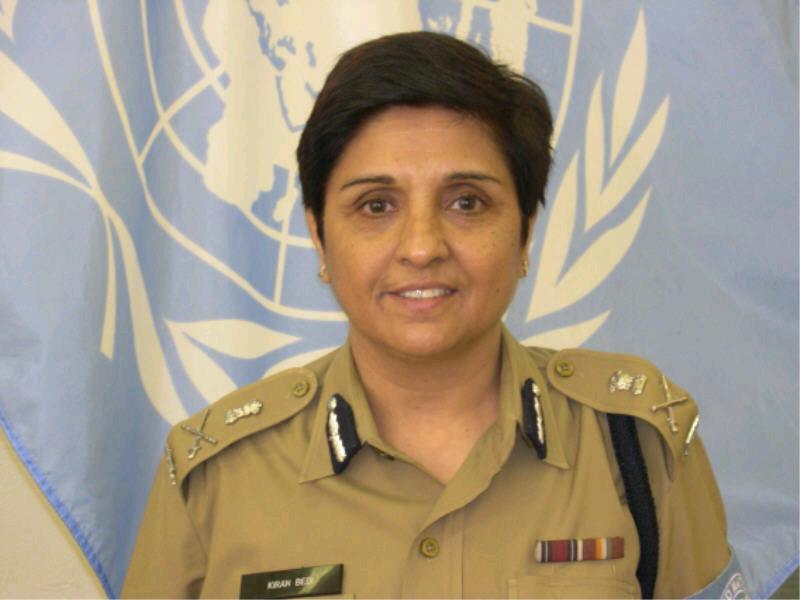 She met Brij Bedi at the Amritsar tennis courts who shared same interests, beliefs and goals. He was nine years elder to her. They married in 1972 in the most unique marriage ceremony of the yesteryears. Neither of them believed in religious ceremonies, or an expensive marriage ritual. Therefore they went to the Shiva temple and prayed, going around the temple seven times. Then they organized a joint reception paid from their combined earnings. They have 4 daughters.
Kiran Bedi was the first woman police officer of the Indian Police Service. Spectators at the 1973 Republic Day Parade were amazed to see a lady at the head of the Police Contingent. The then Prime Minister, Mrs. lndira Gandhi was so impressed that she invited Kiran for breakfast with her the very next day.
Kiran Bedi influenced several decisions of the Indian Police Service, particularly in the areas of narcotics control, traffic management, and VIP security. During her stint as the Inspector General of Prisons, in Tihar Jail (Delhi) (1993–1995), she instituted a number of reforms in the management of the prison, she introduced many classes and programs for the inmates including those on basic education, meditation, yoga besides functions like mushairas, kavi sammelans, dramas and games, which involved the jail inmates. For her effort to humanize the Tihar jail she was honored with the 1994 Ramon Magsaysay Award.
Kiran Bedi laid the foundation for the establishment of two voluntary organizations, namely, Navajyoti (1988) & India Vision Foundation (1994). These organizations were primarily set up with the aim of improving the living conditions of the drug addicts and the underprivileged people. The effort of Kiran Bedi has paid and brought her worldwide recognition. Her works have always earned appreciation. For drug abuse prevention, her organization was presented with the Serge Soitiroff Memorial Award by the United Nations
Kiran Bedi also launched a new website, www.saferindia.com on January 3, 2007. The motto of this website is to help people whose complaints are not accepted by the local police.
She has written her autobiography, 'I Dare. It's Always Possible', which was released in 1998
"Yes Madam, Sir", an award-winning, critically acclaimed film of Kiran Bedi's life, directed by Australian director, Megan Doneman, premiered as an official selection at the Toronto International Film Festival
She met Brij Bedi at the Amritsar tennis courts who shared same interests, beliefs and goals. He was nine years elder to her. They married in 1972 in the most unique marriage ceremony of the yesteryears. Neither of them believed in religious ceremonies, or an expensive marriage ritual. Therefore they went to the Shiva temple and prayed, going around the temple seven times. Then they organized a joint reception paid from their combined earnings. They have 4 daughters.
Kiran Bedi was the first woman police officer of the Indian Police Service. Spectators at the 1973 Republic Day Parade were amazed to see a lady at the head of the Police Contingent. The then Prime Minister, Mrs. lndira Gandhi was so impressed that she invited Kiran for breakfast with her the very next day.
Kiran Bedi influenced several decisions of the Indian Police Service, particularly in the areas of narcotics control, traffic management, and VIP security. During her stint as the Inspector General of Prisons, in Tihar Jail (Delhi) (1993–1995), she instituted a number of reforms in the management of the prison, she introduced many classes and programs for the inmates including those on basic education, meditation, yoga besides functions like mushairas, kavi sammelans, dramas and games, which involved the jail inmates. For her effort to humanize the Tihar jail she was honored with the 1994 Ramon Magsaysay Award.
Kiran Bedi laid the foundation for the establishment of two voluntary organizations, namely, Navajyoti (1988) & India Vision Foundation (1994). These organizations were primarily set up with the aim of improving the living conditions of the drug addicts and the underprivileged people. The effort of Kiran Bedi has paid and brought her worldwide recognition. Her works have always earned appreciation. For drug abuse prevention, her organization was presented with the Serge Soitiroff Memorial Award by the United Nations
Kiran Bedi also launched a new website, www.saferindia.com on January 3, 2007. The motto of this website is to help people whose complaints are not accepted by the local police.
She has written her autobiography, 'I Dare. It's Always Possible', which was released in 1998
"Yes Madam, Sir", an award-winning, critically acclaimed film of Kiran Bedi's life, directed by Australian director, Megan Doneman, premiered as an official selection at the Toronto International Film Festival
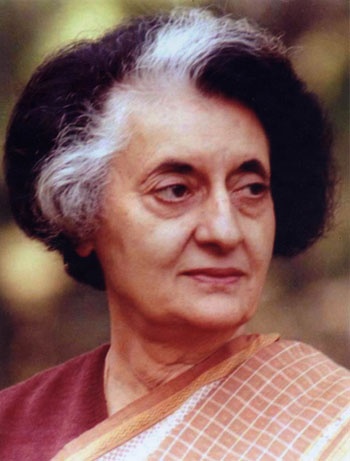
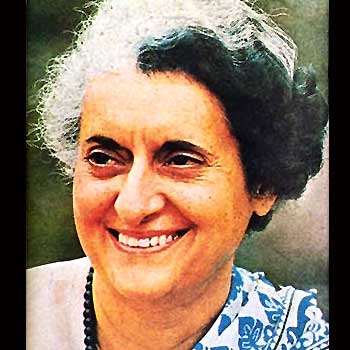
Indira Gandhi was born in an aristocratic family of Nehru on 19 November, 1917, in Allahabad. Her father, Jawaharlal Nehru was a lawyer and also leader of the Indian Nationalist Movement. Indira's mother, Kamala, was a religious lady. It was reported that there was a huge difference between the lifestyle of Jawaharlal Nehru and his wife Kamala. The Nehrus, for traditions, followed a more-western and sophisticated lifestyle. This is one of the reasons her mother had nearly-isolated herself from the values of the Nehrus.

Indira’s Grandfather, Motilal Nehru was a renowned barrister of that period. He was also a prominent member of the Indian National Congress Party. Due to this, lot of noted leaders and party activists would visit the “Nehru House”. Mahatma Gandhi was one of them. Therefore, since childhood, Indira Gandhi had developed an interest in the affairs of country’s politics. Indira Gandhi attended prominent schools including Shantiniketan, Badminton School and Oxford, but she showed no great aptitude for academics, and was detained from obtaining a degree. In 1936, her mother, Kamala Nehru, finally succumbed to tuberculosis after a long struggle. She was eighteen at the time. Jawaharlal Nehru was languishing in the Indian jails that time.

In 1942, she got married to Feroze Gandhi. Two sons were born to her- Rajiv Gandhi and Sanjay Gandhi. Indira Gandhi became the third Prime Minister of India on January 24, 1966 and remained in this post up to 1977. In 1975, her election to Parliament was declared invalid and she declared internal emergency, which led to her defeat in 1977 elections. Indira Gandhi returned to power in 1980 with an overwhelming majority.
She was one of the most efficient Prime Ministers of India and is credited with great achievements. Noteworthy among them are nationalization of banks, liberation of Bangladesh and 20 point programme for the upliftment of the poor. She was honoured with 'Bharat Ratna' in 1971.


Gandhi faced major problems in the areas of food production, population control, land reform, regulation of prices, unemployment, and industrial production. The problems were increased by the arrival in India of almost ten million refugees, who were uprooted as a result of the civil unrest in East Pakistan. In November 1971 Indian troops crossed into East Pakistan to fight Pakistani forces. A month later Gandhi announced recognition of the Bangladesh government set up by East Pakistani rebel leaders. On December 16 Pakistan's commander in East Pakistan surrendered to India.
In the state elections held in India in March 1972, Gandhi's New Congress Party scored the most overwhelming victory in the history of independent India. However, her opponent accused her of violating election laws, and a high court supported the charge in 1975. Because of this development, as well as domestic unrest, Gandhi declared a state of emergency and postponed elections. In the 1977 elections Gandhi and her party suffered major defeats and Gandhi eventually lost her seat and the post of prime minister.
The following year Gandhi headed the Congress Party as she returned to Parliament. In 1979 she again became prime minister. In efforts to prove India's nonalliance in the global community, she visited both the United States and the U.S.S.R., the former Soviet Union, which consisted of Russia and several smaller states. Internally, riots broke out among Muslim, Hindu, and Sikh religious sects, or groups. Sikhs, looking to separate themselves from India, secured weapons within their sacred Golden Temple in Amritsar, and assumed religious protection. Gandhi ordered government troops to storm the temple, leading to many Sikh deaths. This led to her assassination at her residence on October 31, 1984, by her own Sikh security guards. In death, Gandhi remains a symbol of courage and democracy in one of the world's most populated countries.


Early Life
She was born on the 27th of June 1964 at Payyoli, a village located in District Payyoli of Kerala to E.P.M. Paithal and T.V. Lakshmi. Usha was affected by ill health in her early childhood days, but displayed the signs of a great Athlete right in her primary school days.
The queen of Indian track and field for two decades, the woman who was nicknamed 'Payyoli Express'’, Udanpari’, and “Golden Girl” because of her speed on the race-track P. T. Usha, has been associated with Indian athletics since 1979. The sporting legend of India, the symbol of perseverance in Indian sports has been through several trials and tribulations in life. She was born in the Kerala village of Koothali near Perambra in Kozhikode district and brought up in” thrikottur” in thikkodi panchayath and later on habihuted in only one kilometers distance place called Payyoli, As the daughter of E. P. M. Paithal and T. V. Lakshmi and afflicted by ill health in her childhood days. Right from her primary school days Usha showed the spark of athletic talent and was the star of many a sports meet.
Beginning of Athletic Career
The Kerala State Government began a Sports Division for Women at Kannur in the year 1976, and 12 year old P.T. Usha was one among the 40 girls who began their training under O.M. Nambiar, the Coach at the division. She first came into limelight in the year 1979 when at National School Games, she won the individual championship.

Usha School of Athletics, started by her in 2002 at a rented house in Koyilandy near Kozhikode, in Kerala, with Rs 10,000 from her savings, has recently moved into a 30-acre campus in Kinalur village, 20 km from Kozhikode city. Kinalur was in the news recently when the police clashed with villagers who protested a four-lane approach road to the proposed industrial park being set up by the state government-owned Kerala State Industrial Development Corporation (KSIDC) and the Construction Industry Development Board (CIDB), a statutory body established in Malaysia.

In 1976 the Kerala State Government started a Sports division for women in Kannur, and Usha was stared practicing under the guidance coach O. M. Nambiar as one among the forty girls athletes in sports division Kannur. In 1979 she participated in the National School Games, where she won the individual championship and came in to the lime light. Her first international performance came in the 1980 Pakistan Open National Meet at Karachi where she won4 gold medals for the country. In 1982 she won gold medal in 200m.race and bronze medal in 100 m. race in the world junior invitation meet (currently called world junior athletic championship) at Seoul. By 1984, the Los Angeles Olympics, she had improved tremendously; she won the 400 m heats, and missed getting India's first track-and-field bronze medal in the 400m finals by 1/100 sec, in a dramatic photo finish. She put her faith in her natural talent and trusted in God almighty, with the strength from the people of India. She emerged a winner becoming the first Indian sports women to enter the Olympics final at the age of twenty.
Further, in the year 1985 she participated at the Asian Track and Field Championship held at Jakarta, Indonesia and grabbed 5 Gold Medals and 1 Bronze Medal at the championship. At Seoul Asian Games 1986, Usha clinched four Gold Medals in the 200m, 400m, 400m Hurdles and 4x400m Relay races. Unfortunately, she got her heel injured before the Seoul Olympic Games 1988 and still ran for the nation in the same condition, although couldn’t fare well at the event.
Usha bounced back in the year 1989 at Asian Track Federation Meet held at Delhi, and clinched four Gold Medals and two Silver Medals at the meet. At this time, Usha wanted to declare her retirement but as a last innings she participated at Beijing Asian Games 1990 and despite not being fully prepared for the event, she grabbed three Silver Medals at the event.
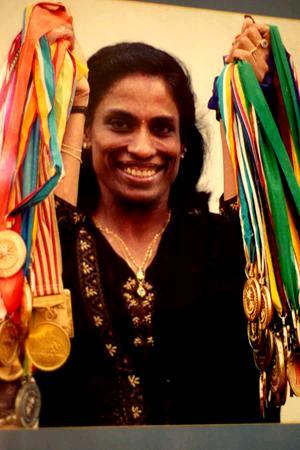
Usha retired from Athletics and married V.Srinivasan in the year 1991, but to the surprise of everybody she made a sudden comeback in the year 1998 and won Bronze Medals in 200m and 400m races at the Asian Track Federation Meet held at Fukkowakka in Japan. At the age of 34 years, P.T. Usha improved her own timing in 200m race and set a new National Record, which was enough to prove the level of Athletic talent still lying inside her.
To commemorate her excellent services to the nation through her consistent and determined efforts towards the sport of Athletics, P.T. Usha was honored with the Arjuna Award in the year 1983 and Padma Shri award in the year 1985. Apart from it, the Indian Olympic Association (IOA) named her the Sportsperson of the Century and the Sports Woman of the Millennium. Also, she was named the Greatest Woman Athlete at Jakarta Asian Athletic Meet 1985 and given the World Trophy for Best Athlete in the years 1985 and 1986.










